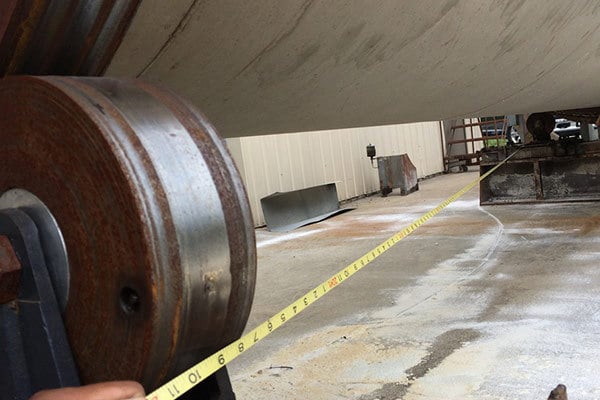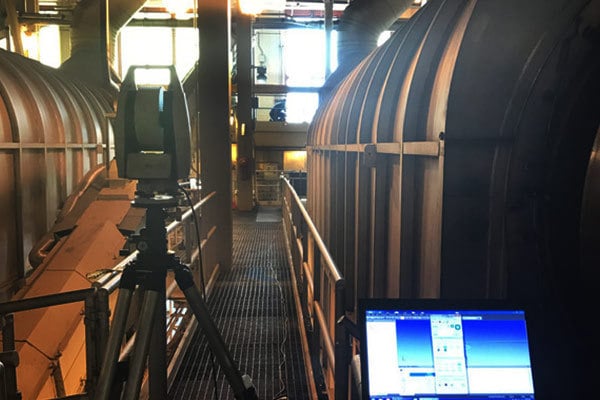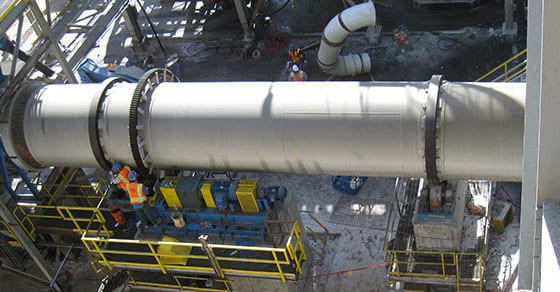As a significant investment and key process device, getting the most out of a rotary drum is a central focus in any production setting. When properly maintained, rotary drums can provide reliable performance for decades. If not properly maintained, however, seemingly-small issues have the potential to escalate into major damage and even catastrophic failure.
One often-overlooked but critical part of maintenance is the need for rotary drum alignment after any major repairs have been carried out. Realignment is an easy and cost-effective way to ensure the drum can perform reliably and efficiently, while minimizing wear on all components and maintaining the integrity of the new repairs.
Consequences of Misalignment
Rotary drum alignment keeps the drum optimally positioned for mechanical stability and proper load distribution. This is referred to as the “float” of the drum, or how the drum rests in its cradle, floating between thrust rollers. Proper float minimizes wear on all components.
A drum that is not aligned after repairs will likely begin wearing to its pre-repair condition, and will put added stress on all components. Resulting wear might include:
- Excessive wear or damage to tires or trunnion wheels
- Damage or wear on thrust roller(s)
- Damage or wear on pinion or girth gears
- Chattering or vibrating drive components
The presence of such issues after repairs have been conducted is highly indicative of improper alignment.
Types of Repairs that Require Realignment
Any major repairs or component replacements will require subsequent rotary drum alignment. One of the most common procedures that necessitates a realignment is the resurfacing of load-bearing surfaces, referred to as tire or trunnion grinding.
Other procedures that will require a realignment include:
- Refractory or liner replacement
- Bearing adjustments
- Frequent wheel skewing
- Repair or replacement of breechings
- Drum shell repair or section replacement
- Girth gear replacement
It’s important to note that rotary drums naturally fall out of alignment over time through normal wear and tear. In addition to post-service work, routine realignment should be performed on a regular basis as part of a preventative maintenance program.
Types of Rotary Drum Alignment
Rotary drum alignment can be conducted in many ways. The two most common approaches are summarized below.
Traditional Alignment (Manual)
Manual alignment is the traditional approach to drum alignment. This method relies on a technician manually measuring a variety of distances and angles to assess how far out of alignment the drum is in its current state.
The technician then uses these measurements to calculate the adjustment needed for the unit to rest in perfect alignment.

Traditional alignment relies on manual measurements, as shown in the image above.
The manual approach to alignment offers a cost-effective option, but is less accurate and more time-intensive than more modern methods. It is also more susceptible to human error.
Laser Alignment
A more advanced approach to drum alignment is the use of a laser tracking system.
Instead of manual measurements, a laser beam measures 3D coordinates while a corresponding software program calculates how far out of alignment the drum is, where adjustments are needed, and how much adjustment is required. This technique allows for incredibly precise accuracy and tight tolerances. It is also much quicker and more reliable compared to the manual alignment method.

Laser alignment relies on a laser tracker (left) and software to measure 3D coordinates with precision accuracy
In addition to drum alignment, the laser alignment system is capable of conducting a number of other tasks on site as well, including:
- Drum base alignment
- Drum shell thickness measurement
- Coupling and shaft alignments
- Elevation checks
- 3D measuring
- Spatial mapping for equipment layout
- Intricate chute design
- Accurate equipment installs
- Flat and circular/tubular pattern layouts
- Plant layouts for existing and new construction
- Horizontal and vertical checks of other process and handling equipment
Whatever method of alignment is chosen, both cold and hot alignment should be performed to achieve optimal drum alignment.
Cold Rotary Drum Alignment
Cold alignment is performed on the drum in its “cold” state, meaning that it is not at operational temperature and is not under operational load.
Checking the cold alignment of a drum is conducted first in order to gather initial data and position the drum relatively close to proper alignment.
Hot Rotary Drum Alignment
Hot alignment refers to the alignment of a drum under normal operating temperature and load. Hot alignment is performed after cold alignment to refine the alignment of the drum while it’s performing at typical operating conditions.
Conclusion
Drum alignment is a major contributor to rotary drum performance and longevity. Alignments should be conducted as part of a regular preventative maintenance program, but perhaps most importantly, after any major repairs have been carried out. Proper alignment after repairs will ensure that the work done is not negated by a misaligned drum, and will promote optimal mechanical stability for reliable and efficient performance.
FEECO is a leader in the manufacture and repair of rotary drums, with over 70 years of experience. If you suspect that your drum is out of alignment, or in need of repairs, contact us today!



